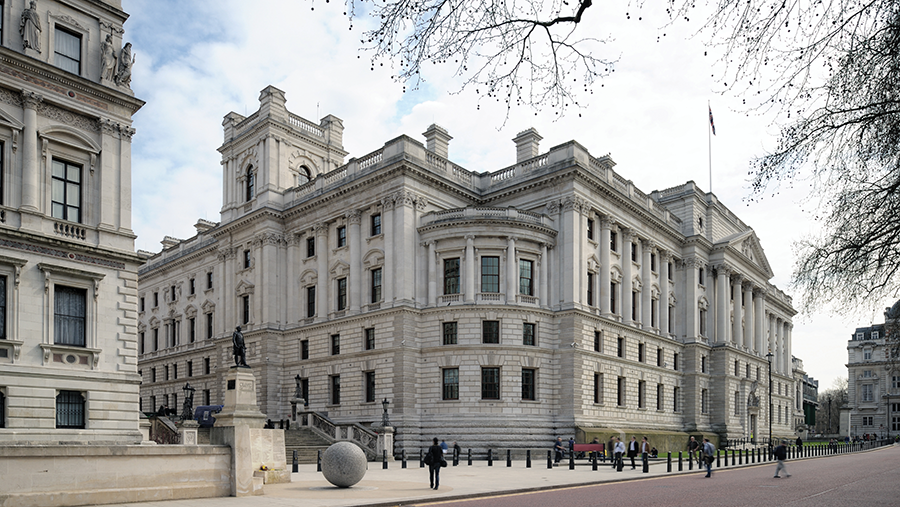Outlook 2021: The economy and farm profitability
 © Adobe Stock
© Adobe Stock Farming has generally been far less affected by the impact of Covid-19 than many other types of business.
However, agriculture will feel the effect in future, perhaps in other ways, according to Andersons partner Graham Redman.
The firm’s 2021 economic outlook says it can be assumed that everybody with income or assets might be expected to help bail out the Government from its unprecedented debt.
Government needs to encourage economic growth and quickly, but is hampered by ongoing restrictions and closures to achieve a low ‘R’ number.
For physical workplaces, rules of social distancing, cleansing, and covering up will affect productivity.
See also: Safe farms, safe staff and visitors – a guide to legislation
In summary
- Growth will rise but from low base after Covid-19 effect on economy in 2020
- Taxes also likely to rise to pay for emergency Covid-19 support measures
- Drive for decarbonisation will create opportunities
Less money earned by fewer hospitality and hotel workers and other badly affected sectors will keep the whole economy from reaching the somewhat tardy 2019 growth levels – probably for five years or longer, says Mr Redman.
Fast growth for 2021
Ironically, economic growth in 2021 should be the fastest this country has seen for decades at potentially 5% or 6%, but from the base of a 10% shrinkage for the 2020 calendar year, this will still leave us considerably poorer at Christmas 2021 than we were at Christmas 2019.
Taxes will rise at some point, but so far the debt has been created by sales of gilts at exceptionally low interest rates, so the urgency to generate additional cash may not have hit the chancellor yet.
Only if the fall in economic turnover reduces revenues beyond his ability to pay for teachers, firemen, police, roadbuilders and some hospitals too, will taxes rise sooner.
Inflation is low and probably will remain so in 2021 as the spare capacity in the workforce restricts wage rises. Deflation might be more of an economic risk. However, several factors should keep the UK from slipping into this spiral.
Unprecedented levels of quantitative easing (printing money) is inflationary, base rates at their lowest for 320 years is inflationary, as is a weak pound.
Brexit
Should a UK/EU deal not be done, then sterling will probably be worth less than it was in October and that is inflationary, which would also be good for farming in the short term.
The outcome of Brexit will affect the economy, but having already suffered the Covid-19 related blow of a 10% drop in GDP in 2020, the Brexit impact on top could be limited to another 4% or 5%, spread over several years.
Whichever forecast is preferred, the world, the UK and British farming have to emerge from Covid and other challenges in a decarbonised manner.
Mr Redman says: “This will leave economic opportunities for those prepared to embrace them but stifle the lifestyles of environmental rejectors not prepared to play their parts in removing carbon from their lives.
“We should consider the 2020s as the transition decade, and we are already 10% of our way through it.
“When change is in the air, opportunity abounds for light-footed and quick-thinking doers.”
Farm profitability
Predicting farming profits is always challenging, but with EU-UK negotiations in the balance at the time of writing and the economic fallout from Covid-19, there may be more fundamental shifts in food demand to come, says Andersons
The firm’s forecasts for farm profitability are based on an ‘orderly’ Brexit with some sort of UK/EU deal, even if it is minimal and limited to preventing tariff barriers.
Defra’s Total Income from Farming (TIFF) series shows the aggregate profit from all UK farming and horticultural businesses for the calendar year.
This is the profit of “UK Farming Plc”, measuring the return to all entrepreneurs involved for their management, labour and capital invested.
The latest Defra figures (2019) show profits rising by 6% in real terms to almost £5.3bn.
Andersons’ own forecasting model suggests returns will fall by about 10% to £4.7bn for 2020, as a consequence of lower crop output and market disruption caused by Covid-19 in the first half of the year.
While some costs have fallen, overheads generally keep rising. For the purposes of forecasting, it is assumed the pound stays in the range €1 = 85-90p.
Given the assumption of a deal of sorts, the profitability prospects for 2021 look reasonably good, says the firm.
With more normal cropping conditions and Covid “managed”, profits in 2021 would rise 5%, to close to £5bn, very much in line with recent years. However, any no-deal outcome would push profits down, probably to less than £4bn, or even lower.
